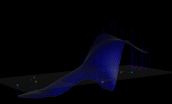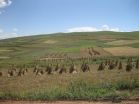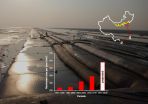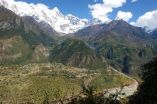(Press-News.org) An international team of researchers has shown that it may be possible to improve the effectiveness of the seasonal flu vaccine by 'pre-empting' the evolution of the influenza virus.
In a study published today in the journal Science, the researchers, led by the University of Cambridge, describe how an immunological phenomenon they refer to as a 'back boost' suggests that it may be better to pre-emptively vaccinate against likely future strains than to use a strain already circulating in the human population.
Influenza is a notoriously difficult virus against which to vaccinate. There are many different strains circulating - both in human and animal populations - and these strains themselves evolve rapidly. Yet manufacturers, who need to produce around 350 million doses ahead of the annual 'flu season', must know which strain to put in the vaccine months in advance - during which time the circulating viruses can evolve again.
Scientists at the World Health Organisation (WHO) meet each February to select which strain to use in vaccine development. Due to the complexity of human immune responses, this is decided largely through analysis of immune responses in ferrets to infer which strain best matches those currently circulating. However, vaccination campaigns for the following winter flu season usually start in October, by which time the virus may have evolved such that the effectiveness of the vaccine match is reduced.
"It's a real challenge: the WHO selects a strain of flu using the best information available but is faced with the possibility that the virus will evolve before the flu season," explains Dr Judy Fonville, one of the primary authors on the paper and a member of WHO Collaborating Centre for Modelling, Evolution and Control of Emerging Infectious Diseases at the University of Cambridge. "Even if it does, though, it's worth remembering that the flu vaccine still offers much greater protection than having no jab. We're looking for ways to make an important vaccine even more effective."
According to the WHO, seasonal influenza causes between 3 and 5 million cases of severe illness each year worldwide, up to 500,000 deaths, as well as significant economic impact. Vaccination policies vary per country, but are typically recommended for those at risk of serious complications, such as pregnant women and the elderly. The seasonal flu vaccine has been described as one of the most cost-effective measures of disease prevention, and vaccination therefore has a large health economic benefit. Currently 350 million people partake in annual vaccination programmes. Yet there is room for improvement.
After gathering an extensive amount of immunological data, the team modelled the antibody response to vaccination and infection using a newly developed computer-based method to create an individual's 'antibody landscape'. This landscape visualises an individual's distinct immune profile like a three dimensional landscape with mountains in areas of immune memory and valleys in unprotected areas. The technique enables a much greater understanding of how our immune system responds to pathogens such as flu that evolve and re-infect us.
A key finding from the work is that upon infection, a response is seen not just to the infecting influenza strain, but to all the strains that individual has encountered in the past. It is this broad recall of immunity, that they term the 'back-boost', that is the basis for the proposed vaccine improvement.
Dr Sam Wilks, one of the primary authors, explains: "Crucially, when the vaccine strain is updated pre-emptively, we see that it still stimulates better protection against future viruses yet this comes at no cost to the protection generated against currently circulating ones.
"Faced with uncertainty about how and when the flu virus might evolve, it's better to gamble than to be conservative: if you update early, you still stimulate protection against current strains - much worse is if you update too late. Rather than trying to play 'catch-up', it's better to anticipate and prepare for the likely next step of influenza evolution - and there is no penalty for doing it too soon."
Professor Derek Smith, also from Cambridge, adds why this may lead to improved vaccines in a relatively short timeframe: "The beauty of this approach is that it would not require any change to the current manufacturing process. From the point that the new strain has been selected through to an individual receiving their shot, the steps will be exactly the same. The only difference would be greater protection for the recipient."
The team is now combining this research with their other work on predicting the way in which the virus will evolve, and plan to combine these two major pieces of work in prospective clinical trials.
INFORMATION:
The international collaboration included researchers from: the Erasmus Medical Center, the Netherlands; the Oxford University Clinical Research Unit & Wellcome Trust Major Overseas Programme and the National Institute of Hygiene and Epidemiology, Vietnam; and the WHO Collaborating Centre for Reference and Research on Influenza at the Victorian Infectious Diseases Reference Laboratory in Melbourne. Its principal funder was the US National Institutes of Health.
RIVERSIDE, Calif. - Yellow fever is a disease that can result in symptoms ranging from fever to severe liver damage. Found in South America and sub-Saharan Africa, each year the disease results in 200,000 new cases and kills 30,000 people. About 900 million people are at risk of contracting the disease.
Now a research team led by a biomedical scientist at the University of California, Riverside has determined that the yellow fever virus, a hemorrhagic fever virus, replicates primarily in the liver. Therefore, other organ failures that often follow in people with the ...
During the development of mammals, the growth and organization of digits are orchestrated by Hox genes, which are activated very early in precise regions of the embryo. These "architect genes" are themselves regulated by a large piece of adjacent DNA. A study led by Denis Duboule, professor at the University of Geneva (UNIGE) and the Federal Institute of Technology in Lausanne (EPFL), Switzerland, reveals that this same DNA regulatory sequence also controls the architect genes during the development of the external genitals. The results published in Science magazine, indicate ...
If you are an active senior who wants to stay younger, keep on running.
A new study involving the University of Colorado Boulder and Humboldt State University shows that senior citizens who run several times a week for exercise expend about the same amount of energy walking as a typical 20-year-old.
But older people who walk for exercise rather than jog expend about the same amount of energy walking as older, sedentary adults, and expend up to 22 percent more energy walking than the 20-something crowd. The study, led by Humboldt State Professor Justus Ortega, was published ...
Animal teeth, bones and plant remains have helped researchers from Cambridge, China and America to pinpoint a date for what could be the earliest sustained human habitation at high altitude.
Archaeological discoveries from the 'roof of the world' on the Tibetan Plateau indicate that from 3,600 years ago, crop growing and the raising of livestock was taking place year-round at hitherto unprecedented altitudes.
The findings, published today in Science, demonstrate that across 53 archaeological sites spanning 800 miles, there is evidence of sustained farming and human ...
China's second great wall, a vast seawall covering more than half of the country's mainland coastline, is a foundation for financial gain - and also a dyke holding a swelling rush of ecological woes.
A group of international sustainability scholars, including Jianguo "Jack" Liu, director of Michigan State University's Center for Systems Integration and Sustainability, in a paper published today in Science magazine, outline the sweeping downsides of one of China's efforts to fuel its booming economy, downsides that extend beyond China.
China's coastal regions are only ...
The Himalaya features some of the most impressive gorges on Earth that have been formed by rivers. The geologic history of the famous Tsangpo Gorge, in the eastern Himalaya, now needs to be rewritten.
A team of German, Chinese, and American geoscientists have namely discovered a canyon, filled with more than 500 m of sediments beneath the bed of the present-day Yarlung Tsangpo River upstream from the gorge. Using drill cores, the scientists were able to reconstruct the former valley floor of this river, which allowed them to reconstruct the geological history of the Tsangpo ...
Doctors have long been mystified as to why HIV-1 rapidly sickens some individuals, while in others the virus has difficulties gaining a foothold. Now, a study of genetic variation in HIV-1 and in the cells it infects reported by University of Minnesota researchers in this week's issue of PLOS Genetics has uncovered a chink in HIV-1's armor that may, at least in part, explain the puzzling difference -- and potentially open the door to new treatments.
HIV-1 harms people by invading immune system cells known as T lymphocytes, hijacking their molecular machinery to make more ...
A team of researchers from Caltech and the China Earthquake Administration has discovered an ancient, deep canyon buried along the Yarlung Tsangpo River in south Tibet, north of the eastern end of the Himalayas. The geologists say that the ancient canyon--thousands of feet deep in places--effectively rules out a popular model used to explain how the massive and picturesque gorges of the Himalayas became so steep, so fast.
"I was extremely surprised when my colleagues, Jing Liu-Zeng and Dirk Scherler, showed me the evidence for this canyon in southern Tibet," says Jean-Philippe ...
Bangkok (Thailand)- A recent study from the Thai-Myanmar border highlights the severe and previously under-reported adverse impact of readily treatable tropical rickettsial illnesses, notably scrub typhus and murine typhus, on pregnancy outcomes, finding that more than one third of affected pregnancies resulted either in stillbirth or premature and/or low birth weight babies.
Conducted by Prof Rose McGready and Assoc. Prof Daniel Henry Paris from the Shoklo Malaria Research Unit (SMRU) in Mae Sot, Thailand, and the Mahidol Oxford Research Unit (MORU) in Bangkok, affiliated ...
LEXINGTON, Ky. (Nov. 20, 2014) - A landmark study published today in the journal Science by an international group of scientists, led by the laboratory of Dr. Jayakrishna Ambati, professor & vice chair of the Department of Ophthalmology & Visual Sciences at the University of Kentucky, reports that HIV/AIDS drugs that have been used for the last 30 years could be repurposed to treat age-related macular degeneration (AMD), as well as other inflammatory disorders, because of a previously undiscovered intrinsic and inflammatory activity those drugs possess.
AMD is a progressive ...





